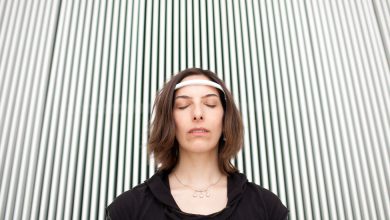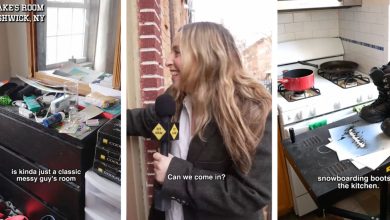Mushrooms and Speed at Alexander McQueen

Alexander McQueen returned to New York, for one night only, with several large piles of pungent dirt and wood chips.
The debris, dumped into a Brooklyn warehouse and then sculpted into tall hills, became the backdrop for the label’s fall 2022 show, which was titled “Mycelium,” after the threaded fungal networks from which mushrooms grow.
Obviously there were mushrooms in the collection, just as one was printed in chartreuse on a poster sent to guests with their invitations. Mushrooms appeared in vibrant colors on tattered oversize knits, growing freaky tendrils via single strands of flowing mohair. They were also on asymmetric sleeveless dresses, piling on top of one another in a psychedelic mélange of crystals, beads and sequins.
But these colors (acid green, candied yellow, Cheetos orange) were more natural than their hues suggested, inspired by photos of fungi, said Sarah Burton, the creative director.
Backstage after the show, Ms. Burton spoke of the duality of the mushroom: “It’s healing,” she said, but it can be toxic as well. “There’s a danger to it.”
When asked if she considered using mushroom leather — several major fashion companies are backing Mylo, a leather alternative made from mycelium — Ms. Burton said no. (There were several all-leather looks, including a banana-colored strapless dress and a deconstructed trench coat in blood red.)
“We actually are trialing it, the mycelium leather,” Ms. Burton said. “But I didn’t want to do it until we actually have enough product to sort of talk about as a story.”
She said that “80 to 85 percent” of the 41 looks in the collection used recycled fabrics, including polyester. The show’s dirt set would also be recycled, donated to an unnamed farm and art project.
Some ideas were recycled, too, from iconic McQueen collections. Two sharply tailored suits were printed with the blurry outline of a human body, like the shadows permanently etched onto stone surfaces after an atomic blast — mushroom imagery of a different kind.
The print on the suits was created from “a shadow of a person moving that we photographed in the studio,” Ms. Burton said, but it also “nodded” to an archival McQueen look: a white dress graffitied with black and yellow paint. At that spring 1999 show, the label’s late founder Alexander McQueen orchestrated two robots to spray-paint the model, Shalom Harlow, in front of a live audience.
Though McQueen has some history in New York — coming here twice in the 1990s, for shows now memorialized in fashion history — there was no clear reason to return now, one week after the end of Paris Fashion Week (where the label typically shows), other than to attend to its American client base after some time away. In late 2020, the company opened a new store in SoHo.
“It’s great to be here to talk to all these women that we dress,” Ms. Burton said, which included, in attendance at Tuesday’s show, Danai Gurira and Letitia Wright, the “Black Panther” stars, and Helena Christensen, the supermodel.
And the momentum of New York had a certain influence on the collection, Ms. Burton said. It was there in her ample slashing: the bandage dress slashed down one leg with cutouts, the blazer slashed vertically down the back, the cigarette trousers slashed vertically from mid-thigh to just below the knee. True to a New Yorker’s wardrobe, all of these pieces were black.
“It’s an exciting city,” Ms. Burton said. “It’s a creative city. It’s not a speedy city, but it is a fast city, and I wanted it to have a pace to it and an energy to it.”



